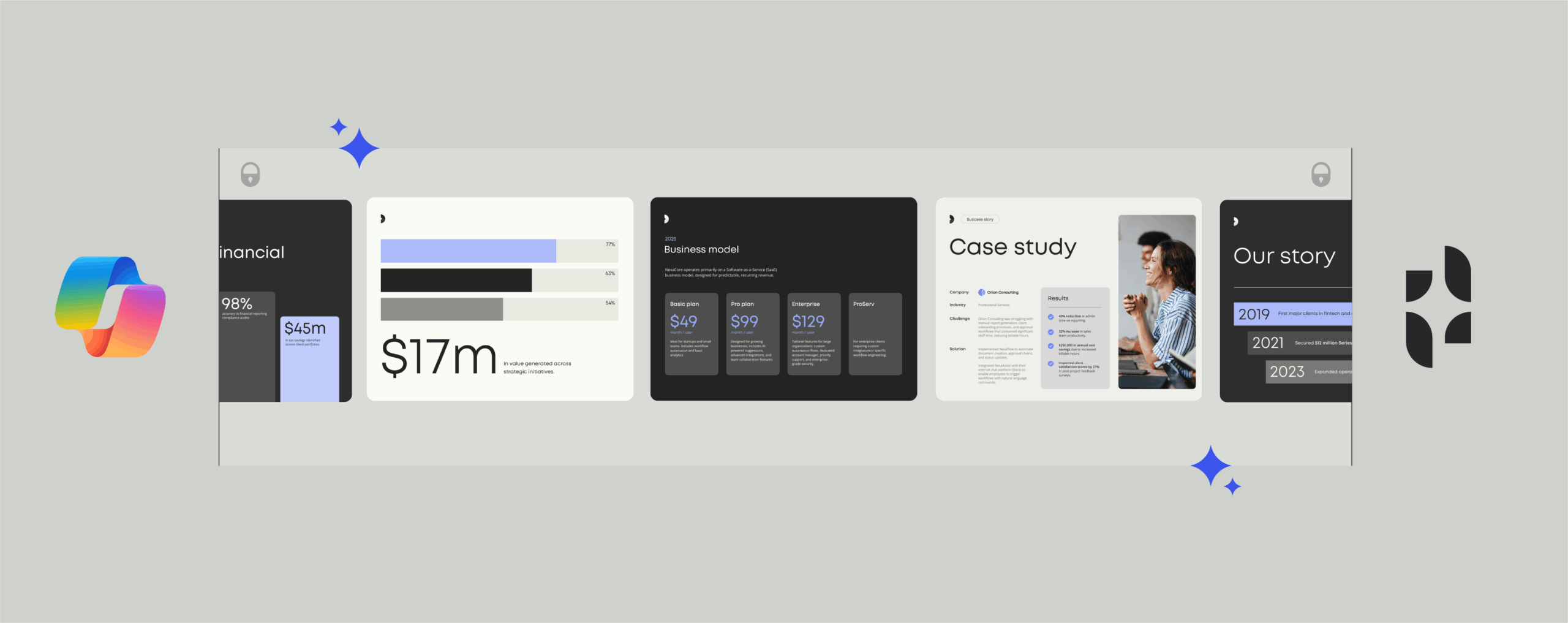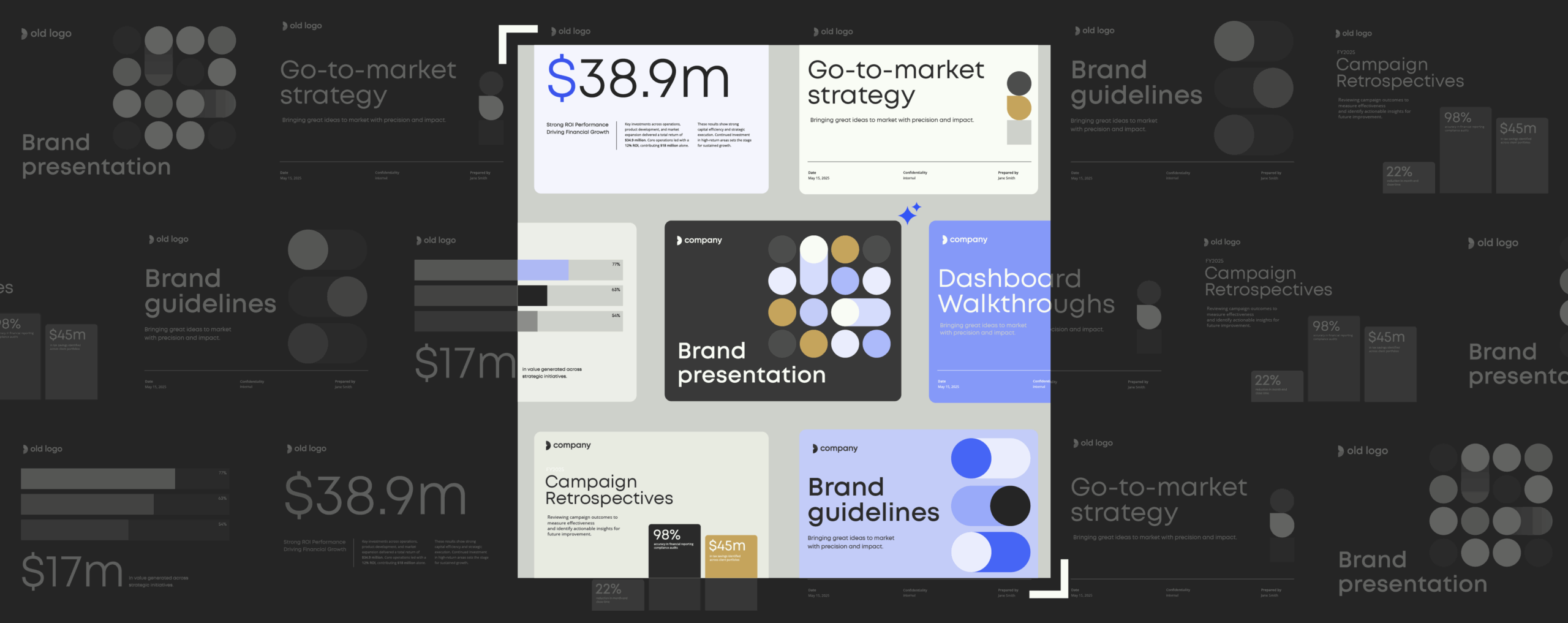Brand compliance explained (and why your teams need it)

What brand compliance means, why it matters, and how to craft a scalable strategy to keep your business protected.
Building a great brand is hard. But ask any marketer, and they’ll tell you: keeping it consistent is even harder. In large, distributed organizations, where content is created across various teams, regions, and platforms, brand consistency is often the first thing to slip.
Without clear brand guardrails, teams start getting ‘creative’: using outdated logos, tweaking messaging, or guessing on the color palette. The result? Inconsistent materials chip away at brand trust and effectiveness.
That’s where brand compliance comes in. It ensures that every document, presentation, or email your organization sends reflects your brand’s identity, voice, and values. When done right, brand compliance secures your reputation, protects you from legal liability, and builds lasting brand value.
What does brand compliance mean?
Brand compliance means making sure all materials created by your organization always follow the same brand rules. That includes using the correct logos, fonts, tone of voice, templates, and legal disclaimers. It’s about keeping your brand consistent and recognizable, no matter who’s creating the content or where it’s being used.
As companies grow, so does the complexity of keeping their brand in check. More employees, more markets, and more channels often lead to more inconsistencies, which can confuse customers and dilute brand value.
And for industries with legal and regulatory obligations, brand compliance also includes following strict guidelines to avoid liability and the risk of penalties. Incorrect disclaimers, outdated templates, or unauthorized messaging can lead to reputational damage, legal issues, or lost trust from customers and stakeholders.
Core components of brand compliance
| Component | What it covers | Examples of non-compliance | Why it matters |
|---|---|---|---|
| Visual identity | Logos, colors, typography, imagery, layout | Old logo in a sales deck, wrong brand color in a social ad | Ensures brand recognition and visual consistency |
| Tone of voice | Writing style, word choice, level of formality, inclusive language | Casual tone in a formal proposal, inconsistent messaging across regions | Builds a unified brand personality across all content |
| Legal disclaimers | Required statements, disclosures, risk warnings, regulatory information | Missing financial disclaimer, outdated terms in a contract | Protects from legal risk and regulatory violations |
| Templates | Pre-approved formats for slides, documents, emails, reports | Manually formatted slide decks, inconsistent cover pages | Saves time and reduces human error |
| Logos and branding | Approved versions, placement rules, sizing, co-branding use | Stretched logo, outdated partner logo, wrong sizing | Maintains brand integrity and professionalism |
| Images and visuals | Style guidelines, licensing, usage restrictions, alt text | Stock photos without permission, inconsistent visual style | Aligns with brand tone and avoids copyright/legal issues |
| Language and region | Translation accuracy, cultural adaptation, correct legal terminology per region | Wrong translation, non-compliant legal term in a specific market | Supports localization and ensures compliance across geographies |
The secret costs of brand non-compliance
Can’t-miss branding tips
Learn how to keep your brand consistent. Get ideas and examples to help your team create on-brand work with less effort.
Brand compliance issues often show up as small mistakes: an outdated logo here, a missing disclaimer there. But the impact runs deeper.
Reputational risk
We’ve seen some pretty egregious examples of corporate communication gone wrong, from sending out an inappropriate email to launching an insensitive product to issuing non-apologies after a PR crisis.
Social media and review sites make it easy for customers to share their experiences, and the bad often motivate more vocal action than the good. A single communication can quickly go viral for the wrong reasons.
If a brand lacks a compliance strategy, it can suffer reputational damage as a consequence, and this can have a large impact on everything from talent acquisition to stock price. This has made reputational risk a top concern among CEOs of the world’s largest businesses, according to a survey by KPMG.
Loss of trust and revenue
Brand compliance is a central part of building trust. If a brand is outdated, inconsistent, or doesn’t adhere to norms and values, it can lead to the brand being perceived as untrustworthy. According to a 2019 Edelman study, this can have a major impact on revenue as 81% of consumers need to trust a brand to consider buying from it.
Decrease in brand value
The most valuable brand in the world is Apple, and the company is a great example of a brand that is consistent in every touchpoint with its customers. Customers and other stakeholders need to see a brand portrayed in a consistent manner to trust it, and if not, this can lead to a decrease in brand value.
Additional content
The latest tools for maintaining brand control and consistency
Here’s what else you need to know about centralizing brand management with Templafy.


How Lyft ended up in legal trouble over a typo
On February 13 2024, Lyft announced their 2023 earnings. The big news was that profit margins for bookings had increased by 5%. As a result of the news, the stock skyrocketed more than 60%. However, a typo had snuck into the earnings report, so in reality, the profit margin had only increased by 0.5%.
Luckily, Lyft had a brand compliance and reputation management strategy in place, so the CEO David Rusher quickly apologized and took full responsibility. Despite the apology, the typo put Lyft in legal trouble as they were faced with a class-action suit.
The incident demonstrates how important it is that all communication sent out by a company is verified and compliant with internal and external guidelines. While a typo can happen to everyone, it could have been discovered before being sent out had Lyft implemented brand compliance procedures.
brand compliance
How to maintain brand compliance at scale
Consistency gets harder as organizations grow. With more people producing content across departments and regions, manual oversight just isn’t realistic. These four tactics help build brand compliance into your everyday workflows:
- Brand governance frameworks
A clear structure helps teams understand what they can (and can’t) change. Governance frameworks outline ownership, decision rights, and approval processes, so the brand is protected without micromanagement. - Centralized asset management
When brand materials live in one place, it’s easy to keep them up to date and hard for teams to go rogue. A centralized platform ensures that everyone is using the same approved logos, templates, and content. - Role-based access and approvals
Not everyone needs access to everything. Role-based permissions and approval workflows make sure the right people can edit or publish assets while keeping compliance risks in check. - Brand playbooks and training
Guidelines only work if people understand them. A clear, visual brand playbook helps employees apply the rules confidently. Ongoing training ensures new hires and seasoned staff stay aligned.
Tools to help manage brand compliance
People will always take the path of least resistance. If creating off-brand content is faster or easier than following the rules, that’s exactly what will happen. The best brand compliance tools flip that dynamic.
The right brand compliance software removes friction, builds guardrails into everyday workflows, and helps teams stay consistent without even thinking about it. When the needed assets, templates, and messaging are right where people expect them to be, brand compliance becomes the default.
Brand compliance features that make staying on-brand easy
| Feature | What it does | Why it matters |
|---|---|---|
| Template and asset management | Centralizes logos, templates, disclaimers, and visuals in one place | Keeps everyone using the most up-to-date, approved materials |
| Access control | Restricts access based on role, department, or region | Prevents misuse of sensitive or out-of-scope brand content |
| Content automation | Auto-fills documents with correct data like contact info, company details, and formatting | Saves time and reduces manual errors |
| Brand monitoring | Tracks how templates and assets are used, flags inconsistencies | Helps identify compliance gaps and training needs early |
| Collaboration integrations | Embeds brand tools in platforms like Microsoft 365 and Google Workspace | Ensures teams can stay compliant without switching tools or breaking workflows |
How Templafy supports brand compliance
Templafy brings brand compliance directly into the tools employees use every day like Microsoft Word, PowerPoint, Outlook, and even Microsoft Copilot.
Instead of jumping between folders, users get everything they need, including templates, brand assets, and approved text right inside their workflow.
By embedding brand control into familiar platforms like Microsoft 365 and Google Workspace, Templafy makes it easier to stay compliant than to go off-brand. Teams don’t have to remember the rules. The platform applies them automatically.
For companies managing content at scale, this means faster creation, fewer errors, and a brand that stays consistent no matter the context.
| Templafy feature | What it does |
|---|---|
| Auto-filled templates | Starts documents and presentations with the correct layout and company data |
| Always on-brand visuals | Ensures logos, fonts, and legal disclaimers are always up to date |
| Targeted user group access | Gives users access based on their role, region, or department |
| Brand monitoring | Tracks how templates and assets are used, helping spot compliance gaps |
| Copilot integration | Works with Microsoft Copilot to insert pre-approved content automatically |
Read more: How Templafy adds guardrails to Copilot
additional content
Brand and compliance for Copilot-generated presentations
See how Templafy enhances Copilot by ensuring business-critical documents are on-brand, and compliant—saving time while improving quality.
Turning brand compliance into a competitive advantage
Brand compliance isn’t just an excuse for marketing teams to assert control. It’s a business priority that affects trust, efficiency, reputation, and revenue. And while the risks of non-compliance are high, the rewards of getting it right are even higher.
With the right tools and structure, brand compliance can become a competitive advantage. It builds consistency, boosts confidence, and protects the integrity of your business across every touchpoint.
Want to see how it works in action? Book a demo with Templafy and discover how easy it is to stay on-brand every time.



